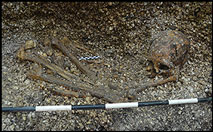No CrossRef data available.
Article contents
The earliest burial from the Caribbean coast of Nicaragua: the Angi shell-matrix site
Published online by Cambridge University Press: 11 December 2018
Abstract

The Caribbean coast of Nicaragua has witnessed relatively little archaeological research. In the last decade, however, there has been a substantial effort to record regional archaeological sites. First excavated in the early 1970s, the Angi shell-matrix site has been subject to new investigations, which have identified the first burial to be recorded on the Nicaraguan Caribbean coast. Although collagen preservation was insufficient for direct radiocarbon dating, samples obtained from surrounding deposits date the burial to c. 3900 BC. This represents both the earliest archaeological feature recorded to date on the Caribbean coast of Nicaragua and the oldest-known human remains from the region.
- Type
- Research
- Information
- Copyright
- Copyright © Antiquity Publications Ltd, 2018


